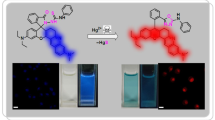Abstract
Liposome is well known as not only a drug-delivery system but also a simple model for biological membranes. It was reported that fluorescence properties of hypocrellins were changeable over some extreme pH values. In the current work, the effects of the microenvironments on the fluorescence properties of HB in liposome, including approximately physiological range of pH values pH = 6.0-8.0, concentration of cholesterols and ionic strength of the solution, were studied. It was found that the fluorescence intensity of HB was sensitive to and also regulated by the microenvironments. When concentration of cholesterols and ionic strength keep invariable in PBS solution, there exists the maximum for the fluorescence of HB-liposome at pH 7.4 while the minimum for that of HB at pH 7.0. In addition, when pH value keeps constant (7.2), there exists the maximum at the ionic strength of 0.12 mol/kg while that at the concentration of 6×10−4 mol/L for cholesterols. On the other hand, in PBS solution, the lower the ionic strength is, the higher the fluorescence intensity is. The environment-sensitive fluorescence may be potentially applicable to probe some specific environmental features in cells or tissues.
Similar content being viewed by others
References
Diwu, Z. J., Novel therapeutic and diagnostic application of hypocrellins and hypericins Photochem, Photobiol., 1995, 61(6): 529–539.
Zhang, Z. Y., Wang, N. H., EPR studies of singlet oxygen and free radicals generated during photosensitization of hypocrellin B, Free Radical Biol. Med., 1993 14: 1–9.
Chowdhury, P. K., Das, K., Datta, A. et al., A comparison of the excited-state processes of nearly symmetrical perylene quinones: hypocrellin A and hypomycin B, J. Photochem. Photobiol. A: Chem., 2002, 154: 107–116.
Hudson, J. B., Zhou, J., Chen, J. et al., Hypocrellin, from Hypocrella bambusae, is phototoxic to human immunodeficiency virus, Photochem. Photobiol., 1994, 60: 253–255.
Xu, S. J., Chen, S., Zhang, M. H. et al., First synthesis of methylated Hypocrellin and its fluorescent excited state: A cautionary tale, J. Org. Chem., 2003, 68: 2048–2050.
Zhang, K. H., Zhang, Z. Y., Molecular thermodynamics of the configuration of perylenequinonoid pigments, Sci. Sin. (B), 1997, 27: 357–360.
Kawakami, M., Koya, K., Ukai, T. et al., Structure-activity of novel rhodacyanine dyes as antitumor agents, J. Med. Chem., 1998, 41(1): 130–142.
Vaupel, P., Kallinowski, F., Okunieff, P., Blood flow, oxygen and nutrient supply, and metabolic microenvironment of human tumors: A review, Cancer Res., 1989, 49: 6449–6465.
Patel, A. A., Gawlinski, E. T., Lemieux, S. K. et al., A cellular automaton model of early tumor growth and invasion, J. Theor. Biol., 2001, 213(3): 315–331.
Vorpai, E. S., Samtso, M. P., Chalov, V. N. et al., Fluorescence of the polymethine dyes, TIKS and diagnostics of cancer, J. Appl. Spectrosc., 2001, 68(3): 468–472.
Zadnia, A., Campbell, R., Sharma, M., The scope of dansyl vs. fluorescein label in fluorescence postlabeling assay for DNA damage, Anal. Biochem., 1994, 218: 444–448.
Yu, C. L., Chen, S., Zhang, M. H. et al., Spectroscopic studies and photodynamic actions of hypocrellin B in liposome, Photochem. Photobiol., 2001, 73(5): 482–488.
Mang, T. S., Dougherty, T. J., Potter, W. R. et al., Photobleaching of porphyrins used in photodynamic therapy and implications for therapy, Photochem. Photobiol., 1987, 45: 501–506.
Shoko, Y., Tadahiro, T., Masahiko, A., Preparation of ganglioside GM3 liposomes and their membrane properties, Colloid Surface B, 2002, 27: 181–187.
Murakami, S., Packer, L., The role of cations in the organization of chloroplast membranes, Arch. Biochem. Biophys., 1971, 146: 337–347.
Angeli, N. G., Lagorio, M. G., San Román, E. et al., Meso-substi-tuted cationic porphyrins of biological interest, Photophysical and physicochemical properties in solution and bound to liposomes, Photochem. Photobiol., 2000, 72(1): 49–56.
Author information
Authors and Affiliations
Corresponding author
Rights and permissions
About this article
Cite this article
Jin, X., Zhao, Y., Xie, J. et al. Fluorescence response of hypocrellin B to the environmental changes in a mimic biological membrane—liposome. Sc. China Ser. B-Chem. 47, 335–339 (2004). https://doi.org/10.1360/03yb0190
Received:
Issue Date:
DOI: https://doi.org/10.1360/03yb0190




